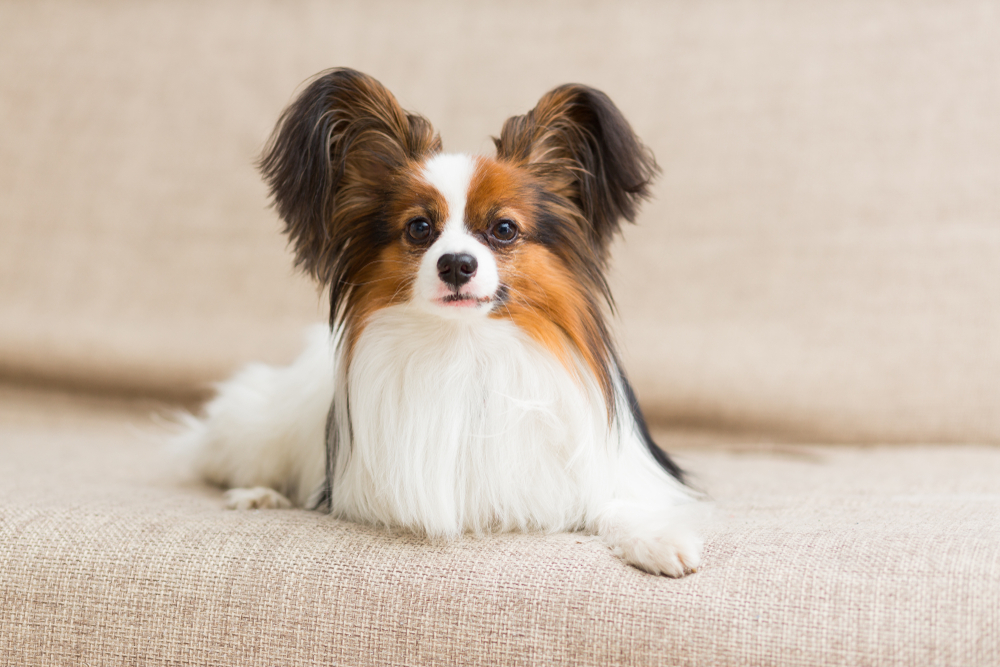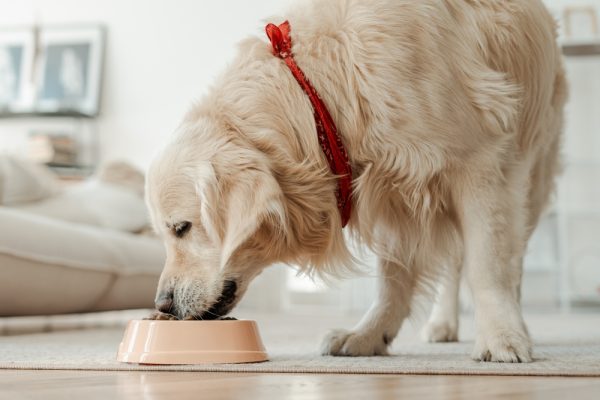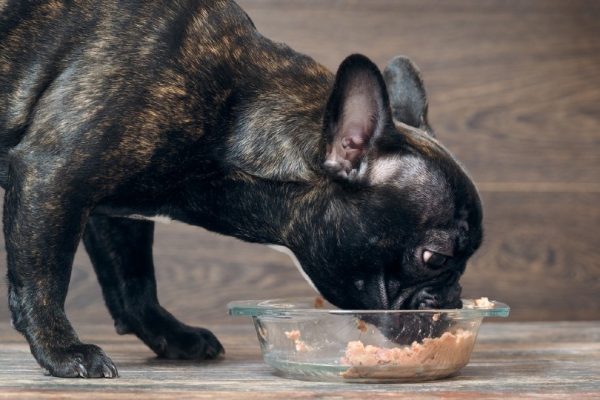In this article
View 4 More +With their adorable and easily recognized butterfly ears, the Papillon has plenty of character packed into their small body. First favored by European nobles during the Renaissance, the Papillon has been a loyal and regal companion for centuries.
So, how much do Papillons weigh, and how big do they get? They’re a toy breed, so Papillons only weigh around 5–10 pounds (2.3 – 4.5kg) and grow to be 8–11 inches tall. They also grow quickly, so it doesn’t take them long to reach their adult size. To help you predict how your puppy will develop, this guide contains everything that you need to know about the Papillon dog’s size and what can affect these metrics.

Papillon Breed Overview
Toy breeds have always been highly favored by the nobility in many countries, and the Papillon is one of the oldest, with a history that can be traced back to the Renaissance. Originally known as the Dwarf Spaniel, the Papillon earned their name from their iconic wing-shaped ears, as “papillon” is the French word for “butterfly.” They were developed by crossing toy breeds with spaniels to create a refined but sporty companion in a small, adorable size.
The Papillon was favored by the French monarchy, with King Louis XIV, Marie Antoinette, and Madame de Pompadour adoring the breed most of all. They were also favored by artists like Rembrandt and featured in many European portraits at the time. However, it wasn’t until the breed was introduced to Italy and Spain that dog lovers in all of Europe began taking notice.
Today, the Papillon is recognized as a devoted family dog that is alert, friendly, and energetic. They do well in all seasons as well as urban and rural homes and have a fondness for agility.
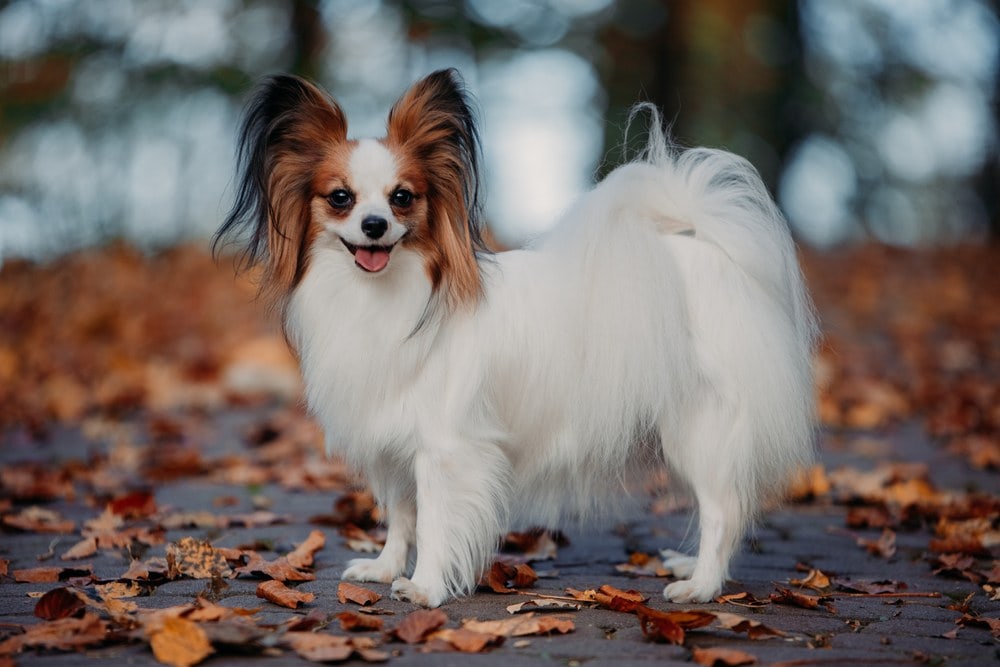
Papillon Size and Growth Chart
A Papillon dog’s weight depends on three factors: their age, sex, and how tall they are. The Phalene version of the Papillon, which has droopy ears, grows at a similar rate to the standard version.
The average adult Papillon stands between 8–11 inches tall, which makes them a toy breed, and they weigh around 5–10 pounds. Your Papillon may weigh more or less depending on their sex, with males generally being larger and heavier than the females.
To give you an idea of your puppy’s perfect weight as they grow, here’s a quick growth chart for both male and female Papillon puppies.
| Age | Weight Range | Height Range |
| 12 weeks (3 months) | 2.2–4.2 lbs | 5–7 in |
| 6 months | 3.8–7.5 lbs | 7–9 in |
| 9 months | 4.6–9.3 lbs | 8–10 in |
| 12 months | 5–10 lbs | 8–11 in |
When Does a Papillon Stop Growing?
Many large breed dogs take up to 2 years to reach their full size, but toy breeds like the Papillon grow much faster. On average, Papillons reach their full adult size when they’re between 9–12 months old.
Some puppies might finish growing sooner than others. Monitoring their weight and size as they grow is crucial to ensure that they’re on track and the right weight for their age instead of under- or overweight.

Factors Affecting the Size of a Papillon
Adult Papillons aren’t big dogs and usually weigh between 5 and 10 pounds. Several factors can determine their ideal adult weight.
1. Diet
A healthy diet isn’t just essential for getting the right nutrition; it’s also important for managing your Papillon’s weight. Eating too much without enough exercise will lead to weight gain.
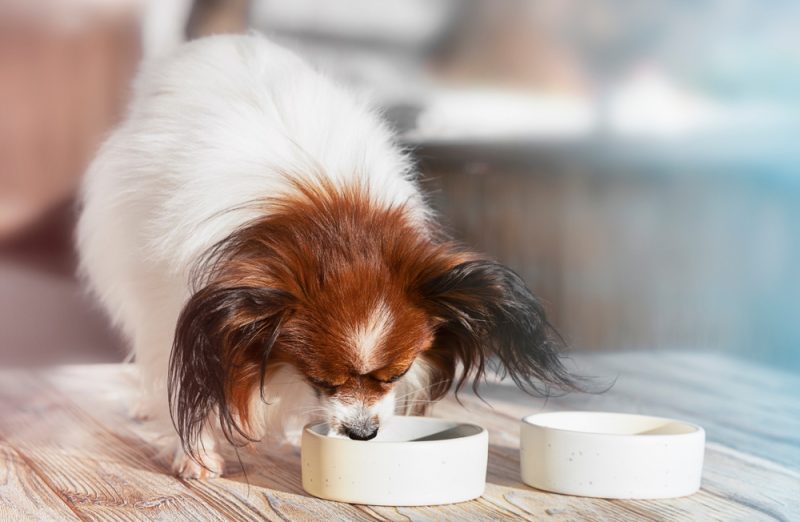
2. Genetics
Always ask about the parents if you visit a Papillon breeder, as this will help you predict how big your puppy will be. If the mother and father are both larger than average, you can expect your Papillon to be the same way.
3. Health
Illnesses and injuries can play a massive part in how well your puppy grows. If their body is focused on healing or they are not eating well because they are ill, they may lose or gain more weight than usual. The amount of exercise that your Papillon gets can affect their health and weight too.
4. Sex
In general, a male Papillon will be slightly larger or heavier than a female, even if they’re the same age or height. This is normal, though individual Papillons will all be different.


Ideal Diet for Maintaining a Healthy Weight
Managing your Papillon’s diet is critical for helping them maintain their weight. You should choose food made with high-quality ingredients, but you also need to consider their health, eating habits, activity levels, and age.
An adult Papillon weighing between 5–10 pounds should eat ¼–½ cup of dry food a day, split into two meals. A puppy less than 4 months old, however, should eat up to four small meals a day to reduce the risk of hypoglycemia.
Always remember to consider the number of treats that you give your Papillon. Treats and other snacks should only make up 10% of your dog’s daily calorie intake, which for a Papillon isn’t much. Too many treats can add additional calories to a healthy, balanced, and nutritional diet and can lead to weight gain, especially if you don’t exercise your dog enough.
We recommend getting advice from a veterinarian if you have any questions or concerns regarding your pet’s diet and weight.
If you need to speak with a vet but can't get to one, head over to PangoVet. It's an online service where you can talk to a vet online and get the personalized advice you need for your pet — all at an affordable price!
How to Measure Your Papillon
Weighing your Papillon at home is easy, and you can use a normal bathroom scale if you have one. There are two ways to do this. The first relies on your Papillon’s training. Place them on the scale, and ask them to “stay” while you note down their weight. Remember to give them a treat once you’re done.
The second way requires a few math skills, but it’s sometimes simpler, especially if your Papillon is feeling too playful or restless to sit still. You’ll need to weigh yourself first, make a note, and then weigh yourself holding your Papillon. Once you have both weights, subtract your weight from the weight of you and your Papillon. This will give you your Papillon’s weight.
To measure how tall they are, you’ll need a tape measure. Ask your Papillon to stand still, and measure the height of the top of their shoulder from the floor.

Conclusion
Papillons are a toy breed and don’t take long to grow. When they’re an adult, their average height is between 8–11 inches, and they will weigh between 5–10 pounds. However, they can weigh more or less depending on their sex, health, genetics, diet, and activity level.
Monitoring your Papillon dog’s weight as they grow is the best way to make sure they’re healthy and aren’t at risk of obesity or other health issues later. If you have any questions about how your papillon is growing or their ideal weight, speak to your veterinarian.
Other Breed Articles to Read:
- Horgi (Siberian Husky and Corgi Mix): Info, Pictures, Care & More
- Corillon (Corgi Papillon Mix): Care, Pictures, Info, & More
Featured Image Credit: Fayzulin Serg, Shutterstock
